CHRISTMAS DAY 2014
Good diabetes management depends on following a routine that runs throughout your day — from the time you get up until your head hits the pillow again at night.
That's because blood sugar levels are in constant flux during the day. They rise after meals and taper off during physical activity. The key to successfully managing type 2 diabetes and its symptoms is to keep your blood sugar levels as stable as possible. That's where a routine comes into play. Here are diabetes management tips to help cover every part of your day:
In the Morning
Check your blood sugar. If you have type 2 diabetes, you should check your blood sugar level every morning before you eat anything, says Marjorie Cypress, CDE, president of health care and education at the American Diabetes Association. This gives you a good baseline idea where you stand and allows you to make adjustments throughout the day.
Eat breakfast. If you skip breakfast, you're already starting your day on the wrong foot. "Many people tend to skip breakfast, and it's one of the most important meals of the day," Cypress says. "You skip breakfast and you get hungrier and hungrier, and that's one of the reasons people tend to overeat later in the day." Eating regular meals will help keep your blood sugar levels steady, but skipping meals and then binging will cause spikes.
Give your feet a once-over. Diabetes can cause your feet to lose feeling because of nerve damage. In extreme cases, a person with diabetes can end up having to have a foot amputated if an unnoticed cut becomes severely infected. Check your feet for any sores or cuts each morning. Also check your shoes before putting them on to make sure there's nothing in your shoe that could cause a sore. You might want to check your feet at bedtime, too.
In the Afternoon
Take a lunch break. Don't eat lunch at your desk — that's a sure way to rush and feel stressed. Instead, sit down somewhere else and eat, then take a short walk afterward. Plan a healthy lunch ahead of time or you might resort to unhealthy fast food. You get a triple-win against diabetes with a lunch break: The regular meal and the exercise help keep your blood sugar level stable, and you can release some pressure from work.
Have healthy snacks on hand. Afternoon snacking is a good way to set yourself up for healthy eating once you're home. "Most people like to snack in the afternoon, and I think that's important because you don't want to get home and start grabbing anything because you're so hungry," Cypress says. By having a sensible snack, you can help keep your blood sugar steady by avoiding a binge later on.
Get a little extra activity. Physical activity is crucial to blood sugar control. When you're active, your cells burn blood sugar through a process that doesn’t rely on insulin. Activity also lets your body use insulin more efficiently. Take the stairs instead of an elevator. Get up from your desk and go talk to co-workers instead of emailing them. Experts recommend getting 30 minutes of physical activity each day, but it doesn't have to be all at once, says Don Kain, a certified diabetes educator with Oregon Health & Science University. Every time you get up and move around, you're adding to your 30-minute total. If you'reworn out from work, he says, try to fit in a short walk in the late afternoon.
In the Evening
Eat a sensible dinner. Don't overeat at dinnertime. Eat a meal that's about the same size as what you ate for breakfast and lunch. The actual amounts of protein, carbohydrates, fruits, and vegetables you should eat will depend on the meal plan that's best for you. As with earlier in the day, maintaining a steady intake of food will make you less vulnerable to blood sugar spikes, especially if you're eating healthy foods.
Work out while you watch TV. Keep moving even as you veg out in front of the tube. Do sit-ups or push-ups during commercials, or march in place. Lift light weights during the show. Even physical activity that’s not aerobic can still aid in your body's ability to use insulin efficiently and maintain stable blood sugar. "Contracting your muscles can helpregulate your blood sugar," Cypress says.
At Bedtime
Check your blood sugar again. Here's where you see how your diabetes management routine pays off. "Checking your blood sugar at bedtime gives you a good idea what happened during the day," Cypress says.
Brush and floss your teeth. Brush in the morning and at night, and floss every night. "People with diabetes are at increased risk for periodontal disease and general dental problems," Kain says.
Apply some lotion. Keep your skin moisturized to prevent peeling, cracking, and developing sores that can be symptoms of diabetes. Apply lotion every night before bed.
A tutorial for making an excellent cream/lotion for face and body at
home you'll find on my blog (http://sunbirdafrica.blogspot.com or on my pinterest board "shea butter".
The very best for diabetic feet too!!

Yummie Yummie Yummie.....
will get rid of too much tummy!









